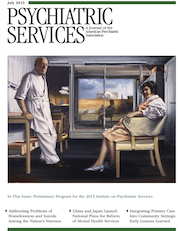Suicide Risk Among U.S. Service Members After Psychiatric Hospitalization, 2001–2011
Abstract
Objective
The rising rate of suicide and the increase in psychiatric hospitalizations in the U.S. military underscore the need to determine risk among service members in psychiatric care so that targeted interventions and prevention programs are implemented. The purpose of this study was to determine the suicide rates of active-duty U.S. service members after discharge from a psychiatric hospitalization.
Methods
Data from 68,947 patients who had psychiatric hospitalizations at military treatment facilities between 2001 and 2011 were obtained from the Defense Medical Surveillance System. Rates of suicide were compared between the cohort group and the general active-duty U.S. military population. Survival analysis was used to determine time-dependent patterns of suicide after hospital discharge.
Results
A total of 153 suicides occurred among the 68,947 service members. The overall suicide rate in the cohort was 71.6 per 100,000 person-years, compared with the rate of 14.2 per 100,000 person-years in the general active-duty U.S. military population. Personnel released from a psychiatric hospitalization were therefore five times more likely to die from suicide. The risk of dying from suicide within the first 30 days after a psychiatric hospitalization was 8.2 times higher than the risk at more than one year after hospitalization.
Conclusions
Active-duty U.S. service members who are released from a psychiatric hospitalization are a group at high risk of suicide. Aggressive safety planning and targeted interventions during and after hospitalization are recommended.



